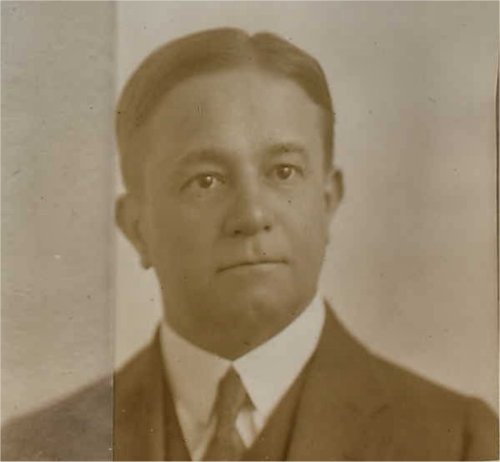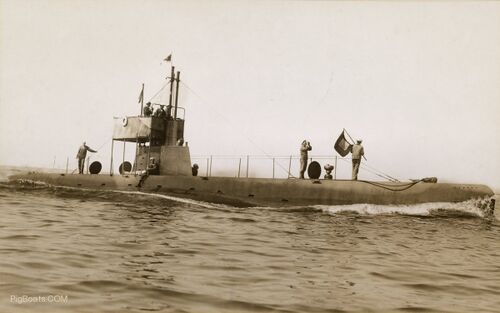Bingham
Captain Donald Cameron Bingham

Donald Cameron Bingham was born in Talladaga, Alabama on Aug 8, 1882. His father was John A Bingham, called Jack, he was the postmaster in their home town of Talladaga. His mothers maiden name was Lilly Schuessler. He had two older sisters, one named Lilly and another named Lena and two younger brothers Chester and Roger.
Bingham entered the Naval Academy on September 1, 1898 and graduated with the class of 1902. He gained his recommendation to the Academy from William Farrington Aldrich the U.S. Representative from Alabama to Congress.
His first several years at the academy had the normal amount if write-ups for housekeeping and personal appearance and even for smiling in ranks.
In October of 1900 at the Academy he seemed to have a hard time about being in proper uniform. In fact out of uniform seemed to plague him through most of his Academy life.

Bingham graduated from the Academy with a grade point of 591.39 graduating him in the top 10 of the class. He seems to have acquired the nickname “Bingy" by this time.
After graduation he was assigned to the Battleship USS Illinois. How long he was there or other ships he may have been sent to is unknown. We do know that by August of 1907 he was in command of the Submarine USS Viper and in 1908 was doing operations in Gardiner's Bay at the east end of Long Island near the Navy's first Submarine Base at New Suffolk.
In October of 1908 Viper, commanded by Bingham, and other submarines participated in studies under the direction of the Board of Inspection of the Navy, with Rear Admiral Thomas C. McLean taking the lead. The trials were looking at the feasibility of sending submarines to the Philippines under tow instead of being carried on ships like the first submarines sent there earlier.
In February 1909 Bingham was promoted to command of the second submarine division and to take command of the submarine USS Octopus from Lieut. Charles E. Courtney.
In October of 1909 Bingham attended the Hudson-Fulton Celebration commemorating the 300th anniversary of Henry Hudson’s discovery of the Hudson River and the 100th anniversary of Robert Fulton’s first successful commercial application of the paddle steamer. He was seated at Table 14 for one of the events and noted as being Commander of a Submarine Flotilla.

By 1910 he was in command of the USS Grayling, (USS D-2) with Ensign Joseph W Jewell as the Executive Officer. While in command of the Grayling and as the Division 3 Commander, a submarine under his command, the submarine Bonita, accidentally rammed the submarine tender Castine holing her. Castine beached herself to prevent sinking. The Castine had had crew members swimming over the side when the Bonita surfaced under the Castine. Bonita was only dented and lost some railing.
In March 1911 the 3rd Submarine Flotilla under Donald Bingham visited the Naval Academy.
In June 1911 the 3rd Submarine Division under the command of Donald Bingham made the trip from Rhode Island to Gloucester, Mass. The boats making this cruise were the Grayling, Bonita. Narwhal, Salmon, Snapper, Stingray and Tarpon. It was noted in the newspapers that these seven boats were submerged in Newport harbor and proceeded to sea, running up Vineyard Sound to Nantucket where the flotilla surfaced and regrouped for the night. They traveled the rest of the way on the surface due to the many shoals in the waters they need to travel in. The next day the subs dove and traveled to Provencetown and maneuvered among the battleships anchored there while submerged before leaving the next morning for Gloucester where they surfaced to enter the harbor.
In July of 1911 Bingham, in command of the submarine Grayling participated in the “Battle of Block Island" , a large fleet war game with the fleet divided into the Red Fleet of 19 ships and the attacking Blue Fleet. Bingham and the Grayling were in the defending Red Fleet. As the attacking fleet got closer under cover of fog and darkness the Grayling, one of seven submarines that went to meet the fleet, popped to the surface right alongside the Blue Fleet flagship, the battleship USS Connecticut. Captain Bingham, as commander of all the defending submarines, casually hailed the ships bridge and asked to moor to their small boat booms. This request caused much consternation aboard the battleship because this meant the fleet line had been breeched and in theory, the battleship Connecticut had been sunk.
Bingham was relieved of his command of the third Submarine Division of the Atlantic fleet and the submarine Grayling in November 1911 and was sent home to wait orders. He was finally assigned as assistant to Lieut. Commander Leigh C. Palmer, director of target practice and engineering competitions.
On June 3, 1913 Bingham reported aboard the battleship USS North Dakota as the staff fleet gunnery officer where he stayed until July of 1915 when he was transferred to the USS Arkansas once more as the staff fleet gunnery officer. In 1917 he reported to the USS Pennsylvania again as the staff fleet gunnery officer. On August 31, 1917 he was promoted to Lieut. Commander. From here out we have lost track of his Naval career, though on July 1, 1919 he has been promoted to full Commander.

Bingham was awarded a Navy Cross for his work in Naval Gunnery in WW I.
In August of 1915 while attached to the Staff of Vice Admiral Mayo he attended a large international social function in Washington DC as Mayo's representative.
In 1924 Bingham applies for a passport to visit Mexico. It seems to be some how associated with his duties as he is to report the the US Mission there as a US Navy advisor. Here we learn some specifics about him from this passport. He is short at 5 feet 1 inch in height. He has brown hair and brown eyes and has a 'round' chin. The passport also has a good photo of him in civilian clothes.
In 1925 Bingham shows up on the USS Concord. He had previously been aboard the USS Dobbin. All in connection with setting up and testing Radio Compass direction finding stations along the Atlantic Coast. It is noted he was assigned Secret Orders to head a board to research radio direction finding compasses in order to find the source of any radio transmissions sent by using a series of radio towers at stations set up along the Atlantic coast.
In 1927, one of the people he worked with while he was involved with Naval Gunnery was Gilbert Jonathan Rowcliff, later a Rear Admiral, who became a specialist in naval gunnery. Bingham gave a dinner party for he and his wife. Among the guests was Capt Emory S Land and his wife. Land was a naval academy classmate of Bingham's.
As best as we can find out he marries a two time widow in or about 1927, the former Bianca S. Cogswell. She is the daughter of Admiral James Cogswell of the Spanish American War fame. Bingham now has two step daughters, one each for her previous marriages, Bianca and Louisa.
He is promoted to Captain in December of 1928 and is in command of Mine Squadron 1 of the Control Force.
He disappears from this point until 1934 where he shows up attached to the US Navy Budget Office. This is apparently his end of career position as he retires from the Navy in 1937 as a Captain.
In 1940 he is living in Chevy Chase , Maryland with his wife Bianca and divorced 27 year old step-daughter Bianca Allen and 17 year old step-daughter Louisa Clement and 52 year old sister-in-law Grace Cogswell.
Through out the war he is continually listed as retired. We do find evidence that he was working for the Navy though in what capacity is unknown. Many retired Navy personnel were used to fill many spots during the war.
Copyright New York Times 1946 Washington. July 24 — Capt. Donald C. Bingham, 63, widely known naval officer, died yesterday [July 23, 1946] of a heart attack, while walking to his home in Chevy Chase, Md. He was not a great distance away from his residence when he collapsed. A native of Talladega, Ala., Bingham had a distinguished career in the Navy, and was a veteran of both World Wars. He was an author of articles on naval and military strategy.
He was buried at Arlington National Cemetery, Virginia, Plot: Sec: 2, Site: 4951
His now thrice widowed wife Bianca seems to have remarried, once again, after Bingham's death. She passed away in 1957.
Page created by:
Ric Hedman & David Johnston
1999 - 2023 - PigBoats.COM©
Mountlake Terrace, WA, Norfolk, VA
webmaster at pigboats dot com
